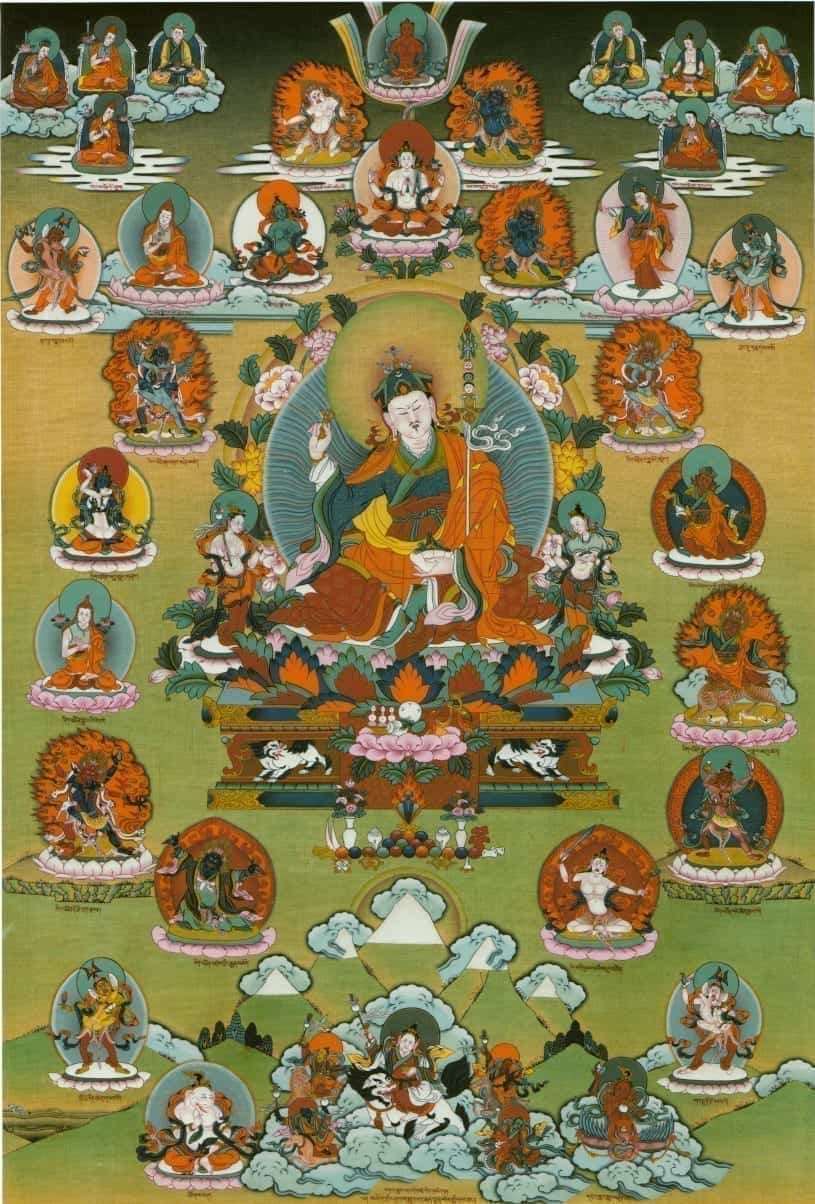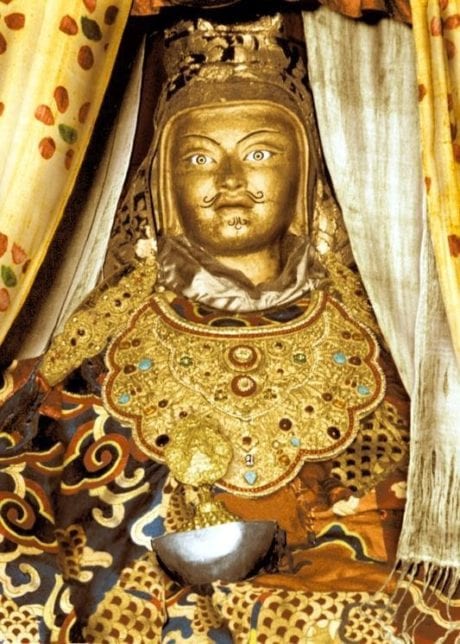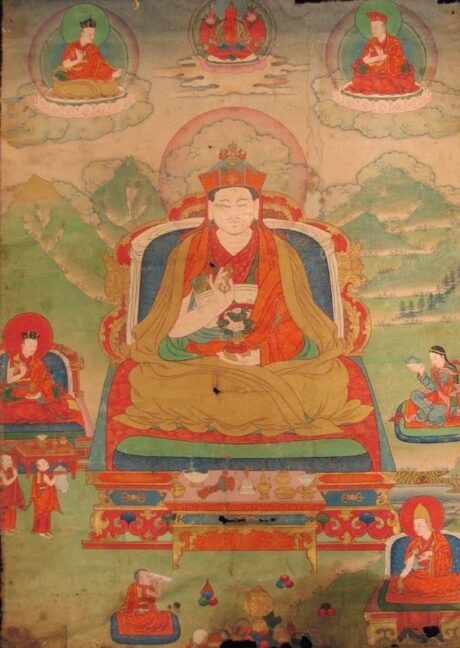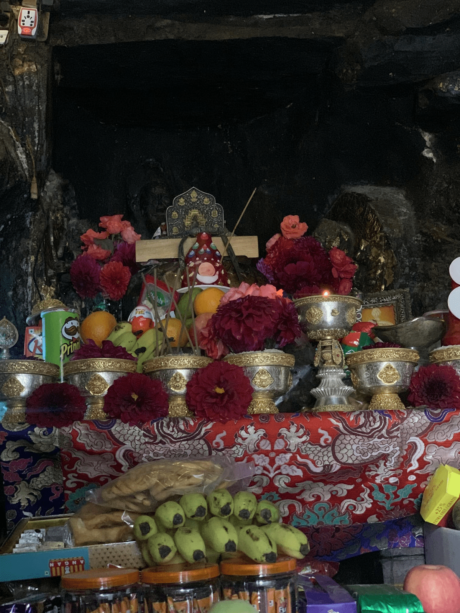
- This event has passed.
Tsok Bum Series: Lamé Tukdrup Barché Künsel (The Guru’s Heart Practice, Dispeller of All Obstacles)
July 29, 2020 @ 8:00 am – 11:00 am +0545

![]() Guru Padmasambhava
Guru Padmasambhava

The Words of Kyapjé Tulku Urgyen Rinpoche
In our own present world age, one thousand Buddhas will appear. Each one will be accompanied by an emanation of Guru Rinpoche to carry out the Buddha’s activities. In the present age of Buddha Shakyamuni, all the Buddha’s activity appeared in one emanation in the form of Padmasambhava, the Lotus-Born One. Padmasambhava lived for a very long time. After his birth, he continued living in India for about one thousand years. Afterward, he arrived in Tibet and remained there for fifty-five years. Before Padmasambhava left Tibet, he made many predictions, hid many teachings to be revealed in the future, and blessed his close disciples to be inseparable from him. In this way, they would reincarnate in the future, reveal the hidden teachings, and be as powerful as Guru Rinpoche himself. In particular, he prophesied the coming of 108 great tertöns, ‘hidden-treasure revealers.’ World history fluctuates, causing particular difficulties to arise at different times. Having foreknowledge of these historic intervals, Guru Rinpoche designed special practices that specific tertöns would reveal at the appropriate times, in order to aid human beings. The tertöns discovering these termas, or ‘hidden treasures,’ would then give a totally fresh, up-to-date teaching meant for that specific time and situation.Chokgyur Dechen Zhikpo Lingpa
 Chokgyur Lingpa was born in Sangyel, at the base of the sacred mountain Namkhadzö in the province of Nangchen, on the tenth day of the sixth month of the earth ox year (August 9, 1829). It is said that Chokgyur Lingpa was the final reincarnation of Prince Murup Tsenpo, second son of Dharma King Trisong Deutsen. Considered in his lineage as the last of the hundred major tertöns, Chokgyur Lingpa is regarded as the tertön meant for our times, with teachings particularly potent for our day and age.
Chokgyur Lingpa was also one of the most prolific treasure revealers of the nineteenth century. His revelations—together with their ancillary materials—span more than forty volumes of Tibetan pecha. They also include the three types of practices which qualify a Treasure revealer as a great treasure revealer—practices related to Guru Rinpoche, the Great Perfection, and Avalokiteshvara. Chokgyur Lingpa, moreover, was a holder of the seven transmissions, as predicted in his Treasure cycle, the Three Sections of the Great Perfection:
Chokgyur Lingpa was born in Sangyel, at the base of the sacred mountain Namkhadzö in the province of Nangchen, on the tenth day of the sixth month of the earth ox year (August 9, 1829). It is said that Chokgyur Lingpa was the final reincarnation of Prince Murup Tsenpo, second son of Dharma King Trisong Deutsen. Considered in his lineage as the last of the hundred major tertöns, Chokgyur Lingpa is regarded as the tertön meant for our times, with teachings particularly potent for our day and age.
Chokgyur Lingpa was also one of the most prolific treasure revealers of the nineteenth century. His revelations—together with their ancillary materials—span more than forty volumes of Tibetan pecha. They also include the three types of practices which qualify a Treasure revealer as a great treasure revealer—practices related to Guru Rinpoche, the Great Perfection, and Avalokiteshvara. Chokgyur Lingpa, moreover, was a holder of the seven transmissions, as predicted in his Treasure cycle, the Three Sections of the Great Perfection:
The unbroken Oral Lineage that comes from the scriptures,
the profound Actual Treasures and profound Mind Treasures,
the Rediscovered Treasures and the Recollected Treasures,
the Pure Vision Treasures and the Whispered Lineages —
the flowing river of these seven transmissions,
the foretold destiny of the king and his son,
will bring honor to the teachings in degenerate times.
They will be profound and vast in reach, spreading further than sunlight.
The king and son mentioned here are Trisong Deutsen and Murup Tsenpo, who were reincarnated respectively as Jamyang Khyentsé Wangpo and Chokgyur Lingpa. Indeed, throughout his activity as a treasure revealer, Chokgyur Lingpa was closely associated with the two figures at the forefront of the non-sectarian Rimé movement – namely Jamyang Khyentsé Wangpo and Jamgön Kongtrül Lodrö Tayé, both of whom participated in many of his treasure discoveries and writings. These three masters were all related as teacher and disciple, each regarding the other two as gurus.Tukdrup Barché Künsel:
The Guru’s Heart Practice, Dispeller of All Obstacles
 According to the terma tradition of Chokgyur Lingpa and Jamyang Khyentsé, there are four levels of heart-practice or guru sadhanas: the outer is Barché Künsel, the inner is Sampa Lhündrup, the secret is Tsokyé Nyingtik, and the innermost secret is Guru Dorjé Draktsal. According to Chokgyur Lingpa’s personal tradition, the primary or root practice is the Gongpa Kündü, Embodiment of All Realization; while the two subsidiary practices are Barché Künsel and Sampa Lhündrup.
According to the terma tradition of Chokgyur Lingpa and Jamyang Khyentsé, there are four levels of heart-practice or guru sadhanas: the outer is Barché Künsel, the inner is Sampa Lhündrup, the secret is Tsokyé Nyingtik, and the innermost secret is Guru Dorjé Draktsal. According to Chokgyur Lingpa’s personal tradition, the primary or root practice is the Gongpa Kündü, Embodiment of All Realization; while the two subsidiary practices are Barché Künsel and Sampa Lhündrup.
Words of Kyapjé Dilgo Khyentsé Rinpoche
The Barché Künsel is the heart essence of the accomplished master Padmasambhava, who perceives the three times in their entirety. It is the quintessence of one billion heart sadhanas of the guru, the most unique terma, buried in the land of Tibet. It is also the first of the Four Cycles of Guru Sadhana. This Guru’s Heart Practice, Dispeller of All Obstacles contains in completeness all the profound key points of the view, meditation, and conduct of the three inner yoga tantras. It manifested from the secret treasury of great wisdom, the vast realization of the Second Buddha of Uddiyana, as self-existing, natural vajra sounds in perfect, melodious tones. Its expressions, which are unmodified by the intellect of ordinary people; its words, which are without delusion; and its meaning, which is unmistaken, are exclusively due to the kindness of the three powerful knowledge holders, Khyentsé, Kongtrül, and Chokling, the great beings of the three families, who incarnated as masters to compile and propagate an ocean of secret teachings. It is exclusively through their kindness that this teaching was established in writing, as the splendor of unending welfare and happiness for disciples in the Land of Snow, and propagated to flourish everywhere. This pure and perfect teaching, which effortlessly bestows, in accordance with one’s wishes, the all-encompassing supreme and common siddhis, temporarily and ultimately, was an unprecedented diffusion of the gemstones of profound meaning, opening up the treasury of the universal monarch.Tsok
The Feast Offering
 Orgyen Tobgyal Rinpoche explained:
All practices on the path to buddhahood are methods for gathering the accumulations of merit and wisdom and for purifying our obscurations. These two processes of accumulation and purification go hand in hand; as we accumulate more merit and wisdom, our obscurations automatically diminish.
The Secret Mantra Vajrayana features countless skillful and powerful methods which, if they are practiced in the proper way, can make the process of accumulation and purification incredibly swift and direct. One such method is the practice of tsok, which is primarily a practice of offering. It is not just a practice of offering however; it is also a powerful method for purifying our samaya.
An immensely powerful way to perform tsok, the feast-gathering, is as a tsok bum, or 100,000 accumulations of the tsok-offering.
As Tselé Natsok Rangdrol states:
The supreme form of merit and wonder is to offer the profound feast-gathering on a vast scale. By making offerings within a group assembly to the deities, gurus, protectors, and vajra brothers and sisters, the two accumulations will be swiftly perfected and all the samayas are restored.
The benefits of performing the feast-gathering are thus immeasurable. Through it, you will perfect the activities of pacifying, enriching, magnetizing, and subjugating. You will restore all impairments and breakages of samaya. You will delight and satisfy the deities, gurus, oath-bound protectors, and vajra brothers and sisters. All unfavorable and unwanted circumstances will be dispelled. You will perfect the two accumulations of merit and wisdom. You will simultaneously accomplish supreme and ordinary siddhis. Through this, you will obtain benefits beyond description.
Orgyen Tobgyal Rinpoche explained:
All practices on the path to buddhahood are methods for gathering the accumulations of merit and wisdom and for purifying our obscurations. These two processes of accumulation and purification go hand in hand; as we accumulate more merit and wisdom, our obscurations automatically diminish.
The Secret Mantra Vajrayana features countless skillful and powerful methods which, if they are practiced in the proper way, can make the process of accumulation and purification incredibly swift and direct. One such method is the practice of tsok, which is primarily a practice of offering. It is not just a practice of offering however; it is also a powerful method for purifying our samaya.
An immensely powerful way to perform tsok, the feast-gathering, is as a tsok bum, or 100,000 accumulations of the tsok-offering.
As Tselé Natsok Rangdrol states:
The supreme form of merit and wonder is to offer the profound feast-gathering on a vast scale. By making offerings within a group assembly to the deities, gurus, protectors, and vajra brothers and sisters, the two accumulations will be swiftly perfected and all the samayas are restored.
The benefits of performing the feast-gathering are thus immeasurable. Through it, you will perfect the activities of pacifying, enriching, magnetizing, and subjugating. You will restore all impairments and breakages of samaya. You will delight and satisfy the deities, gurus, oath-bound protectors, and vajra brothers and sisters. All unfavorable and unwanted circumstances will be dispelled. You will perfect the two accumulations of merit and wisdom. You will simultaneously accomplish supreme and ordinary siddhis. Through this, you will obtain benefits beyond description.
Asura Cave
 As followers of Buddha Shakyamuni, we make the journey to Bodh Gaya. As followers of Guru Padmasambhava, we go on pilgrimage to the caves of Asura and Yangleshö. So vast was Guru Rinpoche’s attainment here that masters such as Kathok Rikzin Tsewang Norbu (1698–1755) have emphasized that these caves are as important as Bodh Gaya for practitioners of the Vajrayāna. This extraordinary place, the single most sacred site connected with Guru Padmasambhava outside the land of Tibet, lies just beyond the Kathmandu Valley’s southern rim, not far from the village of Pharping. For centuries, devotees have traveled to the two main caves here to offer homage at the site of Guru Rinpoche’s attainment of the siddhi of Mahamudra.
Guru Rinpoche engaged in intensive retreat on two of the eight Kagyé deities (Yangdak Heruka and Vajrakilaya) in two distinct caves. The Lower Cave of Yangleshö, or simply Yangleshö, is located just below the village of Pharping. Asura Cave, or the Upper Cave of Yangleshö, is poised in the thick of a forest on the hill immediately behind Pharping. Guru Rinpoche began his retreat focusing on the deity Yangdak Heruka, a wrathful form of Buddha’s wisdom heart, while at the lower cave of Yangleshö. Later at the Asura Cave, he combined Yangdak Heruka with the practice of Vajrakilaya, a deity associated with the Buddha’s enlightened activity and renowned for the removal of obstacles to awakening.
Subsequently, Guru Rinpoche compiled, revised, and systematized the Vajrakilaya teachings. As the result of his exceptional scholarly efforts, the Barché Lamsel prayer praises the Mahaguru as the Pandita of Yangleshö, and invokes him as Guru Mawé Sengé, Guru Rinpoche indivisible from the Buddha of Wisdom, Manjushri.
As followers of Buddha Shakyamuni, we make the journey to Bodh Gaya. As followers of Guru Padmasambhava, we go on pilgrimage to the caves of Asura and Yangleshö. So vast was Guru Rinpoche’s attainment here that masters such as Kathok Rikzin Tsewang Norbu (1698–1755) have emphasized that these caves are as important as Bodh Gaya for practitioners of the Vajrayāna. This extraordinary place, the single most sacred site connected with Guru Padmasambhava outside the land of Tibet, lies just beyond the Kathmandu Valley’s southern rim, not far from the village of Pharping. For centuries, devotees have traveled to the two main caves here to offer homage at the site of Guru Rinpoche’s attainment of the siddhi of Mahamudra.
Guru Rinpoche engaged in intensive retreat on two of the eight Kagyé deities (Yangdak Heruka and Vajrakilaya) in two distinct caves. The Lower Cave of Yangleshö, or simply Yangleshö, is located just below the village of Pharping. Asura Cave, or the Upper Cave of Yangleshö, is poised in the thick of a forest on the hill immediately behind Pharping. Guru Rinpoche began his retreat focusing on the deity Yangdak Heruka, a wrathful form of Buddha’s wisdom heart, while at the lower cave of Yangleshö. Later at the Asura Cave, he combined Yangdak Heruka with the practice of Vajrakilaya, a deity associated with the Buddha’s enlightened activity and renowned for the removal of obstacles to awakening.
Subsequently, Guru Rinpoche compiled, revised, and systematized the Vajrakilaya teachings. As the result of his exceptional scholarly efforts, the Barché Lamsel prayer praises the Mahaguru as the Pandita of Yangleshö, and invokes him as Guru Mawé Sengé, Guru Rinpoche indivisible from the Buddha of Wisdom, Manjushri.
How to Direct Your Practice
Advice on the Feast-Offering Accumulation
by Phakchok Rinpoche
The upcoming series of feast-gatherings will be held at the extraordinary sacred site of Asura. The participants performing the offerings will be the sangha of monks, nuns, ngakpas (tantric practitioners) and lay disciples. In terms of the occasion, it will be held on Guru Rinpoche day, the tenth day of the lunar month. The Dharma to be practiced will successively be the Guru Heart Practices of the Dispeller of All Obstacles (Barché Künsel), The Spontaneous Fulfillment of Wishes (Sampa Lhündrup), The Heart-Essence of the Lake-Born One (Tsokyé Nyingtik), The Powerful Vajra Wrath Guru (Guru Dorjé Draktsal) and The Embodiment of All Realization (Chidril Gongpa Kündü), followed by the Yidam practice of Vajrakīlaya (Dorjé Purba) and the Ḍākinī activity of Kurukulle (Pema Khandro). When offering this feast-gathering, imagine that you are in the extraordinary sacred site of Asura, in the midst of sacred lands. There, visualize that Guru Rinpoche is present in person, as the embodiment of the three kāyas: Samantabhadra and all dharmakāya buddhas; the five family lords and all sambhogakāya deities; and all nirmāṇakāya emanations throughout the three times. All are indivisible from Guru Rinpoche, who emanates every activity without ever wavering from dharmakāya realization—this is how you should visualize and think of him. In this way, we gather the entire mandala of deities for the offering; we gather all the offering articles; we gather many people together for the recitation, both male and female, monastic and lay from all around the world who form the gathering circle of ḍākas and ḍākinīs. As for the motivation, the best among all motivations is that of bodhicitta, the resolve to attain awakening for the benefit of all beings. In terms of samadhi (meditation), visualizing that the Guru is there in person, we make offerings on the outer, inner, and secret level: Outwardly, we offer all the feast articles and substances that have been prepared. Inwardly, we visualize the entire phenomenal world, the vessel and contents, as the feast-offering, and proffer that. Secretly, trusting the indivisibility of our own minds with Guru Rinpoche, we rest in that recognition if we know how to meditate in this way, and if not, we can just think of the non-duality of mind and wisdom. This is the correct way to engage in feast-gatherings and their associated visualizations. In particular, these seven times 100,000 accumulations of feast-gatherings are especially being held this year to benefit the world at a trying time. As we face a pandemic as well as social, political, and economic turmoil in much of the world, it is particularly important for practitioners to accumulate merit and dedicate it to all beings so that they may overcome obstacles and receive temporary and ultimate happiness. It is therefore essential to keep in your hearts all those who are currently suffering while setting your motivation at the beginning of the practice and dedicating the merit at the end. Please keep all these points in mind while performing the feast-gatherings. Notes The short teachings given by Kyapjé Tulku Urgyen Rinpoche and Kyapjé Dilgo Khyentsé Rinpoche are excerpts from the book Dispeller of Obstacles: The Heart Practice of Padmasambhava. If you wish to find out more about Lamé Tukdrup Barché Künsel you can refer to this book:- Padmasambhava. Dispeller of Obstacles: The Heart Practice of Padmasambhava. Trans. Erik Pema Kunsang, ed. Marcia Dechen Wangmo. Rangjung Yeshe Publications: Hong Kong, 2014.
Translations
EspañolУкраїнська
Details
- Date:
- July 29, 2020
- Time:
-
8:00 am – 11:00 am +0545
- Event Categories:
- Phakchok Rinpoche, Asia, Tsok Bum Events, Vajrayana
- Event Tags:
- Українська
Dakshinkali, 44600 Nepal
Related Events

Become a Samye Institute Patron
Create an auspicious connection and join us in our activities of spreading the Dharma and supporting the practice of Dharma students.
- Access to all courses
- Access to our library of video & audio teachings
- Support from Phakchok Rinpoche & Senior Instructors
- Practice Resources
Related Events
About Samye Institute
Samye is a place where students from all corners of the globe explore how to work with their minds in order to lead meaningful lives. Drawing from authentic Buddhist wisdom traditions, our online platform offers live teachings, structured courses, interactive forums, and community for the digital Dharma sangha. Samye Institute aims to be to the digital world what Nalanda was to India and what Samye was to Tibet.




